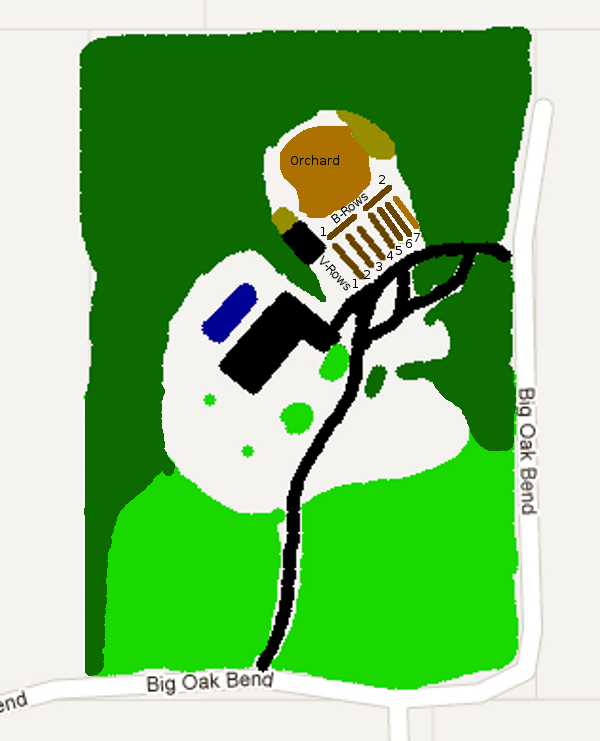I keep thinking about this, and I'm thinking of turning this into the first succession (and the outer edge) of a food forest... What would be a good nitrogen-fixating tree for the parts I'd like to eventually be forest proper, though? Red Alder has all the right properties, but it's a northern plant, so I don't think it'll do well here... What other, more southern Alders are there? Or is there a nitro-fixating tree native to florida that would be good for this?
I'll explain my idea for this a little better before going on;
Here's a rough aerial sketch of my property:

(Ignore the brown designations, they were what I was going to do, but those rows will probably dissolve once I start mulching)
The green areas (light and dark) are natural forest. Not going to cut that down, though I might be willing to plant some pawpaws in the underbrush...
The black rectangular thingy in the center is the house, the other black rectangle is the shed, and the blue is... or, was, the pool.
For now I'm focusing on that upper field, since it has the most potential, but needs the most work.
My plan as it is now is;
1. Wait for late summer.
2. Apply a thick (1 foot deep) layer of cellulose. Logs and tree trunks, if I can find any, will go first on the bottom, along with any cardboard that isn't shredded up. I don't want to smother out the weeds, it's just a necessary evil, due to my impatience... Things like cardboard and paper I'll try to shred up before throwing it down. Paper and cardboard is next, then paper, leaves, horse manure, then if I have any more left more manure left I'll toss it on, leaves, then I'll throw about one to a half- wheelbarrow of forest leaf litter, as a fungal innoculant, OR much more preferably try to find some edible
mushroom spores I can inoculate my forest with instead. Then a layer of leaves on top of it all.
3. Let this sit and decompose for at least 2 weeks, preferably planting as soon as whether permits.
4. When the time starts to seem right, I'll order all of my plants, or if they were ordered as seed, I'll have them ready to transplant by this time. My first succession plant list is currently as follows:
50-75 Goumis (Barerooted, 12-18" plants, from lawyernursery.com)
10 Honeylocusts (Barerooted, still deciding on size but probably 12-18", from lawyernursery.com)
Some kind of nitro-fixating ground cover... Ideas? A mix of plants is preferred, as long as they don't easily out-compete the other, more useful plants. Current ideas are Alfalfa and Clover.
Comfrey (Directly planted from rhizomes, or grown from seed in containers here then transplanted, from horizonherbs.com)
Borage (Either transplanted or direct-seeded, possibly a mix to ensure some plants make it, from horizonherbs.com)
Dandelion (Either direct-seeded from horizonherbs.com, or as a transplant from oikostreecrops.com)
Adding some native plants to this mix would probably also be a good idea, but I can't think of much, besides just letting whatever weeds can grow in this system to do so...
I could probably use some more variety on that list, but then again I only have so much land, and most of the big ones I have to buy in bulk... Plus, I'll likely be replacing or adding-to the plants year by year with other kinds, though I'd like to know more about how exactly the succession should proceed... I'd still like to grow blueberries, but their cost (compared to the other plants) is very prohibitive with my current sources...
Also, should I plant the planned climax plants at the same time as everything else? My list of climax plants, which is basically what isn't listed above, would like to grow some day, and can think of right now, is:
(The and/or listings are plants which can replace each other, if need be. The second plant is more preferred then the first.)
Pawpaw
Blueberry
Pecan and/or black walnut
Mango and/or papaya
Olives and/or avacadoes
Apples and/or peaches
Passion fruit
Kiwi
Grape
Vanilla
Orange
Banana and/or Jackfruit
Custard
apple
Guava
Goji
Flax and/or chia
Buckwheat
Comfrey
Borage
Dandelion
Parsley
Carrot
Melons (all kinds)
Tomatoes
Corn
Dry Beans (for sprouting)
Everything else can can be grown and is edible
Now, of course, I know it's unrealistic to think that I'll be growing ALL of these plants, but it would
be nice to grow as much as I can, with as much variety as I can.
But anyway, how would I build up the soil, essentially from the nothing it is right now, up to a workable food forest, filled with
trees, bushes, and annuals, all self-sustaining, and maintain some level of edibility throughout its establishment? Most particularly, how should I arrange the plants, especially the first-generation goumis, nitro-fixating trees, and various accumulators?







































































































.jpg)
